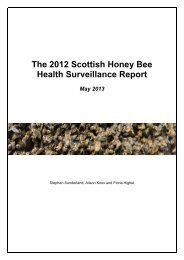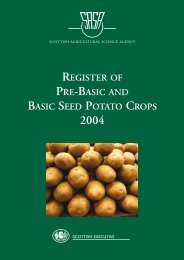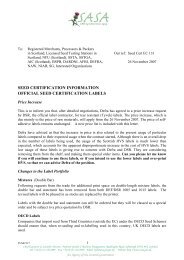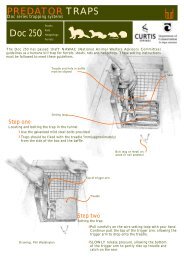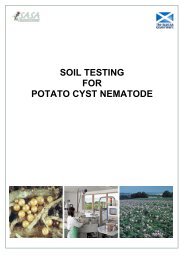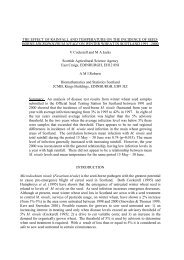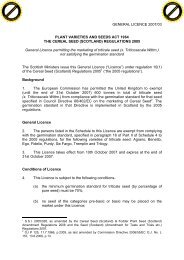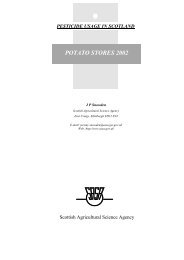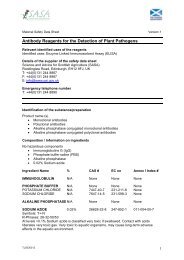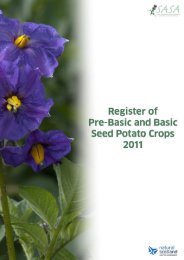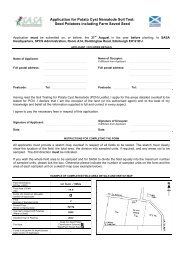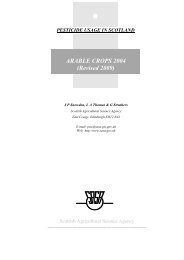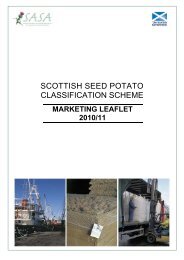Inputs and Susta<strong>in</strong>abilityTable 5.1), but <strong>the</strong>re are major arthropodpests. Wheat bulb fly (Delia coarctata) is acommon pest <strong>in</strong> <strong>the</strong> South <strong>East</strong> <strong>of</strong> <strong>Scotland</strong>,caus<strong>in</strong>g “deadheart” symptoms when larvaefeed on <strong>the</strong> ma<strong>in</strong> shoot. S<strong>in</strong>ce <strong>the</strong> eggswhich will result <strong>in</strong> damage <strong>in</strong> spr<strong>in</strong>g aredeposited dur<strong>in</strong>g <strong>the</strong> preced<strong>in</strong>g summer,preferentially on bare soil, <strong>the</strong> greatest riskis run by w<strong>in</strong>ter wheat crops after potatoes,peas, oilseed rape or set-aside. There is along history <strong>of</strong> wheat bulb fly damage <strong>in</strong><strong>East</strong> Lothian, Fife and Angus, but s<strong>in</strong>ce <strong>the</strong>early 1990s <strong>the</strong>re has been an <strong>in</strong>crease <strong>in</strong><strong>the</strong> number <strong>of</strong> eggs recorded, and <strong>in</strong> <strong>the</strong>range <strong>of</strong> <strong>the</strong> pest (e.g. to <strong>the</strong> Merse) (Evans,2000). This suggests that its <strong>in</strong>cidence andseverity may be chang<strong>in</strong>g <strong>in</strong> response tochanges <strong>in</strong> climate and/or farm<strong>in</strong>g practice(e.g. set-aside and <strong>in</strong>creased areas <strong>of</strong>oilseed rape). Without an effectiveforecast<strong>in</strong>g system, many farmers willcont<strong>in</strong>ue with prophylactic, and <strong>in</strong> manycases unnecessary, <strong>in</strong>secticide applications(see Table 5.1).Of <strong>the</strong> ma<strong>in</strong> crops <strong>in</strong> <strong>the</strong> <strong>East</strong> <strong>of</strong> <strong>Scotland</strong>,<strong>the</strong> potato is most susceptible to <strong>the</strong> fullrange <strong>of</strong> pathogenic taxa, <strong>in</strong>clud<strong>in</strong>g anarray <strong>of</strong> viruses transmitted by leaf-feed<strong>in</strong>gaphids (e.g. <strong>the</strong> peach-potato aphid Myzuspersicae); bacterial diseases such asblackleg (Erw<strong>in</strong>ia carotovora); foliar fungaldiseases, notably late blight (Phytophthora<strong>in</strong>festans); soil-borne nematodes (potatocyst nematodes (PCN) Globodera spp.) aswell as a wide array <strong>of</strong> fungal and bacterialdiseases <strong>of</strong> tubers <strong>in</strong> storage. By exploit<strong>in</strong>g<strong>the</strong> cool climate <strong>of</strong> <strong>the</strong> North <strong>of</strong> <strong>Scotland</strong>(slow build up <strong>of</strong> aphid populations) and acomprehensive set <strong>of</strong> strict regulations(restriction <strong>of</strong> cropp<strong>in</strong>g to PCN-free land;regular field <strong>in</strong>spections; pre- and postharvestdiagnosis <strong>of</strong> virus diseases etc.),<strong>Scotland</strong> ma<strong>in</strong>ta<strong>in</strong>s a highly-pr<strong>of</strong>itable seedtuber <strong>in</strong>dustry, supply<strong>in</strong>g many overseascountries, particularly <strong>in</strong> <strong>the</strong> Mediterraneanzone. Never<strong>the</strong>less, this phytosanitaryapproach does not rule out <strong>the</strong> need forextensive chemical crop protection (e.g.Table 5.1Estimates <strong>of</strong> <strong>the</strong> total usage <strong>of</strong> pesticides on cereal crops <strong>in</strong> <strong>Scotland</strong>,1994, 1996 and 19981994 1996 1998InsecticidesPyrethroids 15,210 46,456 56,648Organophosphates 31,608 15,656 20,993Organochlor<strong>in</strong>es - - 1,157Carbamates 4,192 1,962 2,650Unspecified or mixed formulation - 427 -All <strong>in</strong>secticides 51,010 64,501 81,448Molluscicides 17,025 8,841 30,586Fungicides 1,092,222 1,712,768 1,967,309Herbicides 1,011,474 1,315,092 1,354,105Growth regulators 295,233 388,787 422,748Seed treatments 779,010 830,133 799,005All pesticides 3,245,974 4,320,122 4,655,201Area planted (ha) 395,286 ha 449,298 ha 468,153 haThe data are expressed <strong>in</strong> terms <strong>of</strong> “spray hectares <strong>of</strong> active <strong>in</strong>gredients”.Source: Pesticide Usage <strong>in</strong> <strong>Scotland</strong> Reports. Arable <strong>Crop</strong>s 1994, 1996, 1998. Ed<strong>in</strong>burgh:Scottish Agricultural Science Agency.41
<strong>Crop</strong> <strong>Production</strong> <strong>in</strong> <strong>the</strong> <strong>East</strong> <strong>of</strong> <strong>Scotland</strong>42aphicides, protection aga<strong>in</strong>st blight).Each crop species and cropp<strong>in</strong>g system hasits own characteristic weeds, some <strong>of</strong> whichcan be extremely difficult to control (e.g.wild oats, which are taxonomically, and<strong>the</strong>refore biochemically, close to <strong>the</strong> majorcereal crops). Weeds are controlled byrout<strong>in</strong>e spray<strong>in</strong>g with <strong>the</strong> appropriateselective herbicide (Table 5.1), although allweeds can be controlled by a comb<strong>in</strong>ation<strong>of</strong> rotation and cultivation. Recent work onlow doses <strong>of</strong> herbicide, repeated only ifnecessary, has demonstrated how herbicideusage can be reduced withoutcompromis<strong>in</strong>g crop yield and quality.The extent <strong>of</strong> pesticide applications tocontrol <strong>the</strong> pests, diseases and weeds <strong>of</strong>cereal crops <strong>in</strong> <strong>Scotland</strong> is shown <strong>in</strong> Table5.1 (Note that several <strong>of</strong> <strong>the</strong> values for“spray areas” are greater than <strong>the</strong> actualarea cropped because many crops receivetwo or three applications per season). Thepreponderance <strong>of</strong> herbicide and fungicideapplications reflects <strong>the</strong> practical problems<strong>of</strong> cereal grow<strong>in</strong>g <strong>in</strong> a cool climate, but <strong>the</strong>data also show a dist<strong>in</strong>ct rise <strong>in</strong> <strong>the</strong> use <strong>of</strong><strong>in</strong>secticides, which may be related toclimate change (<strong>in</strong>creased w<strong>in</strong>ter survivaland higher spr<strong>in</strong>g populations <strong>of</strong> <strong>in</strong>sects).Work on <strong>in</strong>tegrated farm<strong>in</strong>g systems hasdemonstrated some <strong>of</strong> <strong>the</strong> ways <strong>in</strong> whichpesticide applications can be reduced.Never<strong>the</strong>less, <strong>the</strong>re is no immediateprospect <strong>of</strong> a substantial reduction <strong>in</strong> <strong>the</strong>level <strong>of</strong> application <strong>of</strong> pesticides, if exist<strong>in</strong>gyields are to be ma<strong>in</strong>ta<strong>in</strong>ed.Risks to humans from pesticides appliedaccord<strong>in</strong>g to codes <strong>of</strong> best practice, arejudged to be low, and <strong>the</strong> accumulation <strong>of</strong>pesticide residues <strong>in</strong> <strong>the</strong> human diet ismonitored by government scientists toensure food safety. On <strong>the</strong> o<strong>the</strong>r hand,pesticides <strong>in</strong>evitably have a deleteriouseffect on biodiversity <strong>in</strong> crops and <strong>the</strong>irmarg<strong>in</strong>s.Inputs: EnergyFossil fuel is required for <strong>the</strong> chemicalsyn<strong>the</strong>sis <strong>of</strong> fertilisers and pesticides; for<strong>the</strong> transport and distribution <strong>of</strong>agrochemicals and o<strong>the</strong>r supplies; fortraction (direct fuel use); and for <strong>the</strong>manufacture <strong>of</strong> mach<strong>in</strong>ery; before anyaccount is taken <strong>of</strong> <strong>the</strong> large energy costs<strong>of</strong> transform<strong>in</strong>g, transport<strong>in</strong>g andmarket<strong>in</strong>g <strong>the</strong> farm yield <strong>in</strong>to food or o<strong>the</strong>rproducts. For example, Slesser (1975)calculated that <strong>the</strong> fossil energy required tomeet <strong>the</strong> direct fuel use, fertiliser andpesticide needs <strong>of</strong> a Scottish spr<strong>in</strong>g barleycrop was equivalent to around 20% <strong>of</strong> <strong>the</strong>solar energy captured <strong>in</strong> <strong>the</strong> harvestedgra<strong>in</strong>; with <strong>the</strong> <strong>in</strong>tensification <strong>of</strong> cerealproduction, <strong>the</strong>se energy costs will be atleast as high now. Intensive agriculture, aspresently practised worldwide, needs to beprimed with oil to secure <strong>the</strong> acquisition <strong>of</strong>solar energy (see <strong>the</strong> pioneer<strong>in</strong>g studies <strong>of</strong>Pimental & Pimental, 1979).Implementation <strong>of</strong> <strong>the</strong> Kyoto Protocol ongreenhouse gas emissions may have asignificant effect on <strong>the</strong> volume <strong>of</strong>agricultural produce which is transportedover long distances, particularlycommodities with a high moisture content.The competitiveness <strong>of</strong> agriculture <strong>in</strong> <strong>the</strong><strong>East</strong> <strong>of</strong> <strong>Scotland</strong> might benefit from anysuch change.Predictable ChangeThe next step <strong>in</strong> evaluat<strong>in</strong>g <strong>the</strong>susta<strong>in</strong>ability <strong>of</strong> arable agriculture <strong>in</strong><strong>Scotland</strong> is to review predictable changes <strong>in</strong><strong>the</strong> physical and biological environment,and <strong>the</strong>ir potential impacts.Current forecasts <strong>of</strong> long-term climatechange <strong>in</strong> <strong>Scotland</strong> are for highertemperatures (typically 1 - 3ºC) particularly<strong>in</strong> w<strong>in</strong>ter, higher w<strong>in</strong>ter ra<strong>in</strong>fall, and drier



